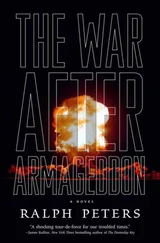“You mean like an atomic bomb?
“Not like a bomb, but just as deadly.”
Botkin moaned. “My God, I don’t want to believe this could happen.”
Scott turned his attention from the coolant piping plan and said over his shoulder, “That’s why some one has to enter the reactor compartment and manually SCRAM the reactor and find the leak, then make repairs.”
Botkin seemed incapable of absorbing what had to be done and acting on it.
Scott finished his study of the reactor’s cooling system and addressed the main propulsion engineer. “What’s your name, sailor?”
“Leonid, sir.”
“All right, Leo, stand by to shift to battery power when the turbogenerators are secured. After we SCRAM the reactor, we’ll need auxiliary power.”
“Aye, Captain.” Leonid’s hands flew over the electrical distribution panel, tripping switches and throwing control levers that opened circuits through which power would flow from the storage batteries to the emergency propulsion system’s motor connect and the ship’s screw.
“Jake, what about the diesel generator?” Alex said.
“The Norwegians, if they haven't already heard the alarm, will spot our snorkel. Not only that, they’ll hear the engine running.”
Scott knew that even if the quench plates could be lowered to shut down the reactor, they'd have to find a way to inject water into the core to cool it. And it might take hours to repair the leak in the main coolant loop. With luck they could design a work-around to isolate the leak. Meanwhile they’d need another source of power to keep the ship's systems working and the prop turning. The battery was the only source available.
“That propulsion motor is a hell of a power drainer,” Scott said, his attention on the flickering ammeters. He knew the ship’s repair gang had less than three hours to perform a miracle before the batteries went flat. If the batteries died, the K-480 would also die. The choice would be to sink or to surface in Norwegian territorial waters.
Scott grabbed the SC1 mike dangling from its coiled cord. “CCP, Reactor Control.”
The starpom answered; Scott heard the man’s voice quaver. “Captain Scott, what is happening, where is the Kapitan?”
“You’re taking orders from me, starpom,” Scott said. “After we SCRAM the reactor, stand by to answer bells on emergency propulsion.”
After a brief hesitation the starpom replied crisply, “Aye, Kapitan. Understood.”
Scott snapped the mike off and said, “Chief, where’s the manual override on the quench plate control.”
The chief mopped his face. “Over the reactor dome. A mechanical interlock: Once it is released with a special tool, it will open the plate clips and gravity will do the rest. But as you said, sir, someone has to enter the reactor compartment to do it.”
“While the reactor is critical and leaking coolant?” Alex said. She looked stunned, as though what Scott had been saying had finally sunk in. “That’s suicidal.”
The K-480’s reactor was located midships on the lower level of Compartment Seven. The compartment had heavy shielding around it to protect the crew from radiation emitted when the reactor, a huge, domed container loaded with enriched uranium fuel, went critical. A shielded tunnel provided safe passage for the crew through Compartment Seven to the machinery spaces aft in Compartment Eight. Midway through the tunnel an airlock, like that in a spacecraft, allowed access to the reactor compartment.
Though radiation levels inside the compartment reached high levels during operation, a man wearing a steam suit and equipped with breathing apparatus could enter the compartment for a short period— under five minutes—and not receive a fatal exposure. Scott knew that it would take more than five minutes to manually drop the plates and quench the nuclear fire.
“It’s the only way,” the chief engineer said to Alex.
“Jake, you can’t allow anyone to go in there,” Alex said. “It’s a death sentence.”
“Someone has to,” Scott said. “If we don’t SCRAM the reactor we’ll all be dead—and so might a lot of innocent people.”
“Then surface the boat and flood the compartment. Surrender to the Norwegians.”
“You don’t mean that.”
“Yes, I do. The hell with Zakayev.”
“You wouldn't risk one life to save the ship so we can head off a terrorist attack?”
Scott stared at Alex, waiting for her answer.
“I’ll do it,” Abakov said. “Show me how.”
They all turned to the FSB officer. “The risk is worth taking,” he said.
“No, Yuri, you can’t go in there,” Alex said. She turned on Scott. “Jake, don't let him.”
“I am the chief engineer,” said Leonid. “I will go.” He picked a steam suit and OBA up off the deck.
Botkin stepped away from the control console and took the suit and OBA away from Leonid. “No. It’s my responsibility. I'm the commanding officer of this ship. I know how to drop the plates.”
Alex started to say something to protest, but Scott trapped her arm in an iron grip.
Botkin stepped one leg at a time into the steam suit and shrugged it over his shoulders. “Chief, assemble a work party. After I drop the quench plates they can follow me in, find the leak, and repair it.”
“Aye, Kapitan,” said the chief engineer.
Scott said, “Kapitan, you'll need an air pack, not that OBA. It’s only good for ten minutes on canister. “We have no air packs.”
Scott didn’t show surprise. “Then take along a spare canister.”
“I'll be done in there before I need a spare,” Botkin said. “At least, I’d better be, or it will be all over.”
Botkin pulled the OBA over his head and face and adjusted the suspension straps. After testing it his breath came in short bursts. “Have a decontamination team stationed outside the airlock when I come out,” he said, his voice muffled behind the mask, “so I don't contaminate the whole ship.”
Leonid helped Botkin get his arms into the shiny suit and zip up. He fit the rubberized material tight around the OBA mask, then hooked up a two-way throat mike for Botkin to communicate with Reactor Control. Finally, Leonid dropped the baglike hood with its rectangular window like a welder’s mask over Botkin’s head, threading the throat mike lead to the outside through a sealed port. Fully outfitted, Botkin looked like an astronaut. Leonid stepped back and gave him a thumbs-up.
Botkin, disoriented by the bulky gear and the limited vision it provided, waddled toward the open door, which led to the shielded tunnel and airlock. Scott put a hand on Botkin’s shoulder and stopped him. Somehow the young skipper had found the inner reserves of strength he needed to enter the possible death trap waiting for him in the reactor compartment.
Scott sketched a salute. “Everything is in your hands now, Kapitan. Everything.”
Botkin lifted a gloved hand, then entered the tunnel.
14
Over the North Atlantic
Air Force One streaked east at forty thousand feet. The president, shoes off, dozed in a comfortable armchair. A formidable pile of briefing folders lay untouched on the table beside him. The first lady, engrossed in a paperback novel, sat opposite her husband. She had fine features, hair like a helmet of tight curls, and skin the color of polished rosewood.
The curtain drawn across the doorway of the private stateroom fluttered. The president’s wife looked up and saw Paul Friedman's face poking around the curtain.
“Sorry, Mim,” Friedman said, using her nickname.
“Can’t it wait?” she asked, annoyed.
Friedman shook his head The first lady shook her head too. “Lord, there’s not a moment’s peace.” She marked her place in the book with a finger, then gently roused the president.
Читать дальше












